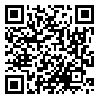BibTeX | RIS | EndNote | Medlars | ProCite | Reference Manager | RefWorks
Send citation to:
URL: http://journal.rums.ac.ir/article-1-1813-en.html
Background and
Objective: Studies have indicated the high
prevalence of Obsessive-Compulsive disorder in childhood period. Inflated
responsibility beliefs are hypothesized to become a central feature of Obsessive-Compulsive
disorder (OCD). Given the
prevalence of this disorder among children and adolescents as well as further
investigation in this field, the present study aimed to investigate the
psychometric properties of a Persian version of Responsibility Beliefs scale.
Materials
and Methods: In this psychometric study, the
Persian version of "Responsibility Beliefs Questionnaire" was
completed by 547 15 to 18-year-old students in Shiraz city. Subjects were
selected by multistage random cluster sampling data were analyzed using
confirmatory factor analysis.
Results:
In this study four-factor structure found in original scale, was confirmed by
confirmatory factor analysis representing heightened responsibility, Actions
Caused/Actions Influenced, Rigid Rules and Overprotection Scales forming
responsibility construct in second-order confirmatory factor analysis. In
addition, results revealed satisfactory Composite Reliability Index (ranging
from 0.60 to 0.85)
Conclusions:
These results support the reliability and validity of the Persian version of
Responsibility Beliefs scale in Iranian adolescents and suggest that this scale
may be useful for studying the etiology of inflated responsibility beliefs that
are hypothesized to become central in order to development of OCD. However,
future research is needed to confirm these data in OCD patients.
Key words: Obsessive-compulsive disorder,
Inflated responsibility beliefs scale, Confirmatory factor analysis, Psychometric
properties, Adolescents
Funding:
This research was funded by article Authors.
Conflict
of interest: None declared.
Ethical
approval: The Research Committee of Shiraz
University of Medical Sciences approved the study.
How to cite this article: Halvaiepour Z, Nosratabadi M. Validation of the Persian
Version of Responsibility Beliefs Questionnaire in Iranian Adolescents. J Rafsanjan Univ Med Sci 2014 13(5): 471-80. [Farsi]
Received: 2013/07/14 | Accepted: 2014/11/26 | Published: 2014/11/26
| Rights and permissions | |
 |
This work is licensed under a Creative Commons Attribution-NonCommercial 4.0 International License. |






